Text
Rigel: Orion's Brightest Star
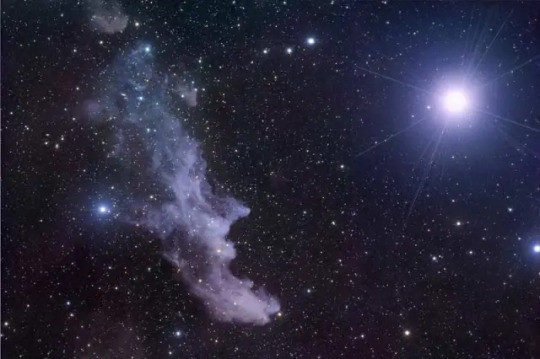
Rigel is a star you can easily spot in the night sky. It is the brightest star in the constellation Orion (the hunter) and the seventh brightest star in the night sky. But did you know that Rigel is not just one star but a system of four stars? And that is a blue supergiant, one of the most massive and luminous stars in our galaxy? I will be focusing on Rigel and its companions in this post.
What is Rigel?
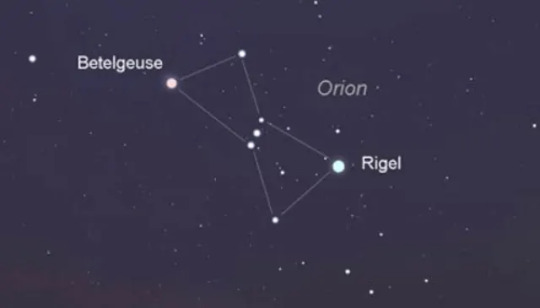
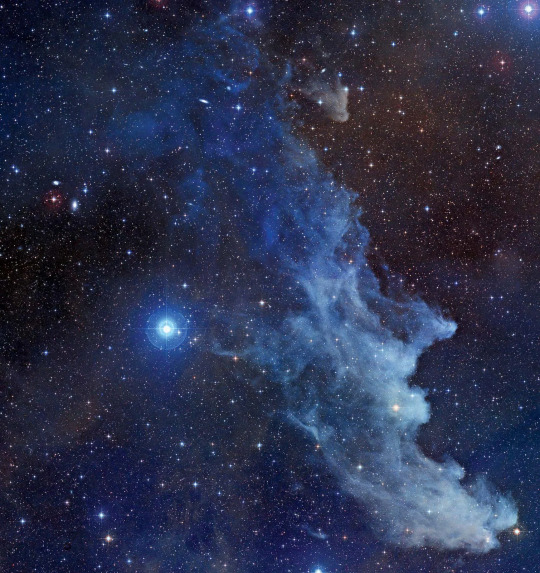
What are Rigel’s Companions?
Rigel is not alone in its orbit around the center mass of the system. It has three companions: Rigel Ba, Rigel Bb, and Rigel C. These are all main-sequence stars, which means they still burn hydrogen in their cores. They are also blue-white, with spectral types of B9 V. They have similar masses and radii, ranging from 2.94 to 3.84 times that of the Sun and from 2.5 to 3 times that of the Sun respectively.
Rigel Ba and Rigel Bb form a close pair that orbits each other every 9.86 days. They are so close that they cannot be seen separately, even with powerful telescopes. They are called a spectroscopic binary because their orbital motion can be detected by measuring the Doppler shifts in their spectral lines.

Rigel A and Rigel Bc form an even wider pair that orbits each other every 24,000 years. This pair can be seen with binoculars or small telescopes under good conditions.
There is also a fifth star that may be part of the system, but it is not confirmed yet. It is a faint red dwarf star of magnitude 15.3 that lies about 220 arcseconds* away from Rigel A.
*(Arcseconds, also known as arc-seconds or arc seconds, are a unit of angular measurement used in various fields, including astronomy, geodesy, and navigation. They are a subdivision of an arcminute, a unit of angular measurement equal to 1/60th of a degree.)
How Did Rigel Form and Evolve?
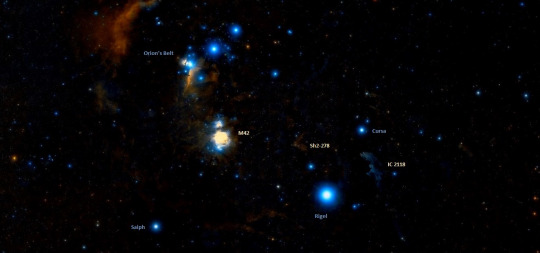
Rigel started as a massive main sequence star that burned the hydrogen in its core very quickly. As the hydrogen was depleted, the star began to contract and heat up, while its outer layers expanded and cooled down. As a result, Rigel became a supergiant star.
Rigel will continue to fuse heavier elements until it reaches iron, which cannot release any more energy by fusion. (Stars undergo fusion reactions in their cores, where lighter elements combine to form heavier elements, releasing energy in the process of fusion. A fusion process continues until the core contains predominantly iron. At this point, the process of fusing iron requires more energy than it releases, slowing down. This process poses a problem because fusion reactions provide the outward pressure that counteracts the inward pull of gravity, supporting the star against collapse. Without the energy generated by fusion, the star loses its means of support and can eventually collapse under its gravity.) At this point, Rigel will collapse and explode into a supernova. But this won’t happen for another million years or so.
The supernova explosion will destroy most of Rigel’s mass and eject it into space as gas and dust. The training core will either become either a neutron star or a black hole, depending on how massive it is.
The fate of Rigel's companions will depend on how close they are to Rigel when it explodes. If they are too close, they will be destroyed or disrupted by the shock wave and radiation from the supernova. If they are far enough, they will survive but may be affected by the change in gravity and radiation from the remnant.
Rigel is important for several reasons. First, it is a prominent star that helps us identify the constellation of Orion and find other stars in the sky. Second, it is a bright and nearby example of a supergiant star, which helps us understand the evolution and fate of massive stars. Third, it is a complex star that challenges our ability to observe and measure its components and interactions. Fourth, it is a potential supernova progenitor that may explode in the near future (in astronomical terms, of course) and provide us with a spectacular show and valuable data.
Rigel is also important for cultural reasons. It has been known and named by many civilizations throughout history, and it has been associated with various myths and legends. In ancient China, Rigel was called Shang Zuo, meaning "the left-hand seat of the king," and it was part of the Three Stars asterism that represented the emperor's throne. In Arabic, Rigel was called Rijl al-Jawza', meaning "the foot of the central one," referring to Orion as a giant. In modern times, Rigel has been featured in many works of science fiction and fantasy, such as Star Trek, The Hitchhiker's Guide to the Galaxy, and The Chronicles of Narnia.
Rigel is a fascinating star that deserves our attention and admiration. It is not only a beautiful sight in the night sky, but also a rich source of scientific information and cultural inspiration. I hope you enjoyed learning about Rigel and its companions, and I encourage you to look for them the next time you gaze at the stars. And as always, this blogger has to sign out, Stay With Wonder!
5 notes
·
View notes
Text
The Loneliest Whale

In the vast expanse of the world's oceans, where countless species roam, one particular creature stands out—a symbol of solitude and yearning. This extraordinary creature, known as "the loneliest whale," has captivated the hearts and imaginations of scientists, filmmakers, and nature enthusiasts alike. In this blog post, we will delve into the captivating story of the loneliest whale, exploring its mysterious existence, the science behind its unique communication, and the profound lessons it teaches us about loneliness and connection.
The Tale of the Loneliest Whale:
The loneliest whale first gained attention in the late 1980s when scientists discovered its distinct vocalizations. Unlike most whales, which communicate within a frequency range of 12 to 25 hertz, this enigmatic creature emits calls at a frequency of around 52 hertz. This frequency is much higher than the typical range of other whale species, making it difficult for them to hear its calls.

The Isolation and Mystery:
The loneliest whale's isolation stems from its inability to communicate effectively with other whales. While most whales rely on vocalizations to find mates and socialize, the higher frequency of the 52-Hertz Whale's calls prevents it from effectively communicating with its counterparts. As a result, it has been swimming through the vast ocean alone, seemingly condemned to a solitary existence.
The exact reason for the loneliest whale's unique vocalizations remains a mystery. Some theories suggest that it may be a genetic anomaly or a result of a physical deformity. Others propose that it could be a hybrid between different whale species or a solitary individual with its own unique dialect. However, no concrete answers have emerged, leaving room for speculation and wonder.
Lessons from the Loneliest Whale:
The story of the loneliest whale evokes a sense of empathy and contemplation within me. It serves as a poignant reminder of the importance of connection and the profound impact of loneliness on living beings. As humans, we can empathize with the yearning for companionship and the inherent need for social bonds.
The loneliest whale's plight compels us to reflect on our own lives and the connections we foster. It reminds us to cherish and nurture the relationships we have, to reach out to those who may feel isolated, and to work towards a world where no one is left unheard or unseen.
The loneliest whale's tale is one of mystery, solitude, and longing. Its haunting calls reverberate through the depths of the ocean, capturing our imaginations and reminding us of the power of connection. While the loneliest whale may swim alone, its story unites us in a shared appreciation for the beauty and fragility of life. And with that, I’m going to cry. Stay With Wonder!
#marine life#animals#whale sub#sea creatures#marine#whale watching#whale weekly#whale tail#52 hertz#whalien 52
39 notes
·
View notes
Text
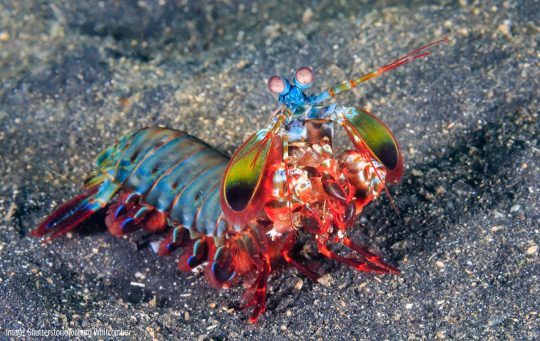
The Mantis Shrimp: Nature’s Marvelous Boxer(The name is misleading. They are neither mantis nor shrimp)
In the mesmerizing world of marine life, the mantis shrimp stands as an extraordinary creature that captivates researchers, scientists, and nature enthusiasts alike. With its kaleidoscope of colors, fascinating behavior, and unique set of abilities, this small but mighty marine marvel has earned a reputation as one of the ocean’s most intriguing inhabitants. Join me as I take you into the captivating world of the mantis shrimp, exploring its incredible features and astonishing capabilities.
The Master of Color:

A Formidable Hunter:
The mantis shrimp’s exceptional hunting prowess makes it a force to be reckoned with in the ocean’s depths. Equipped with appendages resembling a praying mantis, these crustaceans(Crustaceans are a diverse group of arthropods that includes familiar animals such as crabs, lobsters, shrimp, and barnacles. They are characterized by having a hard exoskeleton, a segmented body, and jointed appendages.) are skilled predators that employ two distinct hunting strategies:” spearers” and “smashers” *
-Spearers: Some mantis shrimp species have spear-like appendages that they use to impale and capture prey with lightning-fast precision. They strike so swiftly that the prey has little time to react, making them highly effective hunters. (Do you get the pun now?)
-Smashers: Other mantis shrimp species boast club-like appendages capable of generating an incredible amount of force. They use this power to deliver devastating blows to their prey or even shatter the hard shells of crabs and mollusks, enabling them to feast on well-protected creatures.
Unmatched vision:
The mantis shrimp’s eyes are nothing short of extraordinary, possessing one of the most complex visual systems in the animal kingdom. Unlike humans, who possess three types of color receptors (cones), mantis shrimp have up to 16 different types of cones, enabling them to see colors that are beyond human comprehension. This remarkable visual system allows them to perceive polarized light,(Polarized light refers to a type of light in which the vibrations of the electromagnetic waves are confined to a single plane. This means that the electric field vectors of polarized light oscillate in a specific direction, perpendicular to the direction of propagation.) a phenomenon that helps them navigate, communicate, and hunt effectively.
A Creature of Beauty and Brawn:
Despite their striking appearance, mantis shrimp are relatively small, ranging from a few centimeters to about 15 inches in length. (38.1 cm) They typically inhabit shallow tropical and subtropical waters, often hiding in burrows or crevices within the coral and ambushing unsuspecting prey.
Remarkable Communication:
In addition to their incredible vision, mantis shrimp have developed a unique form of communication. They use body movements, color changes, and even gentle taps to convey messages to other individuals, signaling territorial boundaries or courtship interests. Their complex communication methods contribute to the fascinating social dynamics within their communities.
In the enigmatic world of marine life, the mantis shrimp stands as a true wonder, embodying nature’s ingenious adaptations and remarkable capabilities. From their awe-inspiring colors and exceptional hunting techniques to their unmatched visual system and intricate communication methods, these marine marvels continue to amaze and inspire those who dare to explore the secrets of the ocean. As we uncover the mysteries of the underwater world, the mantis shrimp will undoubtedly remain an enduring symbol of nature’s marvels and evolutionary wonders. Stay With Wonder!
#mantis shrimp#peacock mantis shrimp#marine life#marine biology#ocean life#sea life#sea creatures#deep sea#underwater
103 notes
·
View notes
Text
Betelgeuse: A Celestial Giant On The Verge Of Stellar Drama
In the vast tapestry of the night sky, this week's star is Betelgeuse. This red supergiant*, nestled in the constellation Orion, has captivated astronomers and stargazers alike for centuries. Its brilliance, size, and intriguing characteristics make it an astronomical wonder worth exploring. This week I will go over the fascinating facts about this star in hopes that this mesmerizing star will fuel the same wonder in you, same as me. So without further ado, let's discover!
Not a Static Bacon!
Betelgeuse is a variable star and not a static bacon. (I understand when I put it like this it all seems like nonsense, so I will try to explain to the best of my abilities. Static bacon is a celestial object that maintains a stable level of brightness over time. Most stars fall under this category like our sun. But some stars like Betelgeuse are variable stars that show differences in brightness over time. These fluctuations can be attributed to internal processes such as pulsations, eruptions, or interactivity with neighboring stars.) with a pulsation period of 420 days, this giant experiences regular changes in brightness. These pulsations give Betelgeuse its characteristic flicker.
Betelgeuse-How To Pronounce

Shine Bright Like Betelgeuse
Despite being 640 lightyears away from Earth, Betelgeuse shines with exceptional brilliance due to its immense size and luminosity. Let me put it this way, if this star was as close to Earth as our sun, it would outshine the sun, completely dominating the daytime sky. (By the way, diamonds don’t shine, they reflect, so that lyric is iconic but untrue.)
Color and Temperature
Betelgeuse shines with a reddish-orange hue, which tells us that this star's surface temperature is cooler than our sun. With an estimated temperature of 3.500 to 3.800 degrees Celsius(6.332 to 6.872 degrees Fahrenheit), this red supergiant is easy to spot.
Stellar Winds and Nebula
As a red supergiant star, Betelgeuse experiences powerful stellar winds, driven by radiation pressure from its core. Over time these winds shed the outer core of the stars which leads to an awe-inspiring mass of gas and dust surrounding Betelgeuse-The Betelgeuse Nebula.
Ancient Observations
Betelgeuse has been observed by civilizations throughout history. The star's variations in brightness have been recorded in ancient Chinese, Arabic, and European astronomical texts. Its significance in various cultures and its prominent position in the constellation Orion have made it a subject of fascination for generations.
Imaging Efforts
Despite its proximity and prominence, capturing detailed images of Betelgeuse's surface has proven challenging. Due to its distance, its angular size is tiny compared to other stars, making it difficult for telescopes to resolve its features directly. Nevertheless, advanced imaging techniques and interferometry have provided valuable insights into the star's characteristics and helped astronomers study its dynamic atmosphere.
Due to its massive size and advanced stage of evolution, Betelgeuse is expected to undergo a supernova explosion at some point in the future. When this happens, it will be one of the most spectacular events visible from Earth, possibly shining as brightly as the full moon for a short time and becoming easily visible during the day. However, it is essential to note that astronomers can't predict exactly when this supernova will occur, as it could be tomorrow or thousands of years in the future. And with that, this blogger has to sign out, as always, Stay With Wonder!
*I will make a post on my pinned list about star classification systems so you may always refer to it when you need it :)

18 notes
·
View notes
Text

If you are looking for a new animal to admire, you might want to check out the leaf sheep, a species of sea slug that has some remarkable features. The leaf sheep, also known as Costasiella kuroshimae, is a tiny marine creature that lives in tropical waters near Japan, the Philippines, and Indonesia. It has a striking appearance, resembling a cartoon sheep with green leaves on its back. But what makes the leaf sheep even more fascinating is its ability to perform photosynthesis, a process usually reserved for plants.

The leaf sheep is a type of sea slug that feeds on algae. It belongs to the family Costasiellidae, which includes about 20 species of colorful slugs that have leaf-like protrusions on their backs. The leaf sheep was discovered in 1993 off the coast of the Japanese island Kuroshima and was named after its location. It can grow up to 1 centimeter in length and has two dark eyes and two rhinophores (sensory organs) that look like sheep's ears or insect antennae.
## How does the leaf sheep photosynthesize?


The leaf sheep is not only a cute and curious animal but also a valuable subject for scientific research. By studying how the leaf sheep manages to maintain the chloroplasts and photosynthesize, researchers can learn more about the evolution and adaptation of life forms, as well as the potential applications of biotechnology. For example, some scientists have suggested that the leaf sheep could inspire the development of artificial photosynthesis, which could help produce renewable energy and combat climate change
An interesting fact about them that made them the animal of the week.
We simply do not know how long they live. Some scientists argue that with photosynthesis, they must live to be very old, but we have no solid facts confirming or denying this theory. It fascinates me that with all the tools we have now for research, we do not know how long a small slug can live. In my closing words, I must point out that these species should not be kept as pets. We do not have enough knowledge about them to know how to treat them. I understand that this fact may be disappointing, but you can enjoy photos of them online to satisfy your adorable meter! And with that, I will see you next week with another animal of the week. Stay with Wonder!
8 notes
·
View notes
Text
Vega: The Enchanting Star in the Summer Sky

Gazing up at the night sky, we find ourselves captivated by the celestial wonders that surround us. Among these cosmic gems, one star truly stands out with its radiant beauty and captivating charm. Meet Vega, the enchanting star that graces the summer sky with its brilliance. In this blog post, we'll embark on a delightful journey to discover the magic and allure behind this celestial gem.
A Star with a Shimmering Personality:
Vega, also known as Alpha Lyrae, is a dazzling bluish-white star located in the constellation Lyra. It is one of the brightest stars visible from Earth, and its brilliance has been captivating stargazers for centuries. With a luminosity more than 50 times that of our Sun, Vega truly shines like a diamond in the sky.
The Harbinger of Summer Nights:
Vega has earned its place in folklore and culture across the globe as a symbol of summer. As the second brightest star in the northern hemisphere, Vega takes center stage during the warm summer months, guiding us through the enchanting nights. Its radiant glow is a testament to the beauty and wonder of the cosmos.
A Celestial Speed Demon:
Vega's allure doesn't end with its luminosity. This star is also known for its rapid rotation, spinning at an astonishing rate of over 270 kilometers (168 miles) per second at its equator. Due to this fast rotation, Vega has a slightly flattened shape, resembling a celestial pancake. Isn't that just adorable?
An Ancient Navigator:
Vega's captivating presence extends beyond its beauty. In ancient times, navigators used Vega as a guiding light during their voyages across land and sea. It played a vital role in helping sailors and travelers find their way, acting as a celestial compass in the night sky. It's incredible to think that this twinkling star has been a reliable guide for countless adventurers throughout history.
The Star of Extraterrestrial Dreams:
Vega's allure has even reached the silver screen. In the 1997 film "Contact," based on Carl Sagan's novel, Vega takes center stage as the target of a message from extraterrestrial beings. Its proximity to Earth and its captivating radiance make it a popular choice when imagining distant civilizations and interstellar communication.
Vega, the enchanting star of the summer sky, continues to capture our hearts with its luminosity, rapid rotation, and storied history. Whether you're stargazing on a warm summer night, navigating through uncharted territories, or dreaming of distant galaxies, Vega is there to guide, inspire, and ignite our imaginations. So, the next time you find yourself under the starry canopy, take a moment to appreciate the charm and magic of Vega, the celestial gem that brightens our nights and fuels our cosmic curiosity. Stay With Wonder!
26 notes
·
View notes